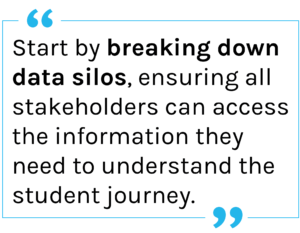How recruiting, teaching, and graduating students is a team effort for HigherEd institutions.

The numbers are clear: students are not enrolling in or graduation from college at the same rate as they were before the pandemic. Data released in January reveals that more than one million fewer students are enrolled in college or university now than in 2020. The decline has been steep and continuing: HigherEd institutions saw an undergraduate student drop of almost 500,000 students in the fall of 2021. Experts speculate that this change may not be temporary—younger generations seem to be thinking in new ways about the value of a degree. With changing attitudes towards higher education and declining enrollment numbers, colleges and universities need to get creative in attracting applicants, retaining students, and setting them up for success. This is not just the responsibility of faculty—it’s all-hands-on-deck. Read on to learn how your entire institution can get involved in student outcomes.
Bringing students, faculty, and staff on board
Recruitment is vital for every institution in this changing higher education landscape—both recruiting students and recruiting the faculty and staff to support them. From the admissions side, there are many tactics being explored to boost applicant rates and attract students. Some colleges are taking action through targeted recruitment to specific groups of students, like adults who have partial degrees, offering discounts for them to return to finish that degree. Other colleges are listening to advice to make changes internally to draw applicants organically, making sure that they have the right technology in place to communicate with interested applicants and to support a seamless digital experience for students once they are enrolled.
Recruitment on the faculty and staff side is another important factor in increasing enrollment and improving student outcomes. Inside HigherEd reports that individual instructors can have a huge impact on student retention rates, and there is evidence that a diverse faculty body improves student retention rates, especially for minority students. Hiring top talent, building diverse faculty and staff applicant pools, and prioritizing professional development are all key to filling your institution with the right employees to drive student success.
Student success
One institution, Georgia State University, has taken the prioritization of student success to heart, launching a program that has increased their graduation rate 23% and reduced the time to degree. The program was launched to tackle the university’s achievement gaps that fell along race, ethnicity, and income level lines, and has so far been a huge success. The program prioritizes academic and financial support, using data analysis and predictive analytics to make sure that struggling students get the support and advising that they need. A program like this can have a huge impact on a university trying to stand out from its peers, but even small investments in student support or predictive analytics can be beneficial, and everyone can help.
Start by breaking down data silos in every area of your institution, ensuring that all stakeholders can access the information they need to understand the student journey. Your human resources team could dive in by helping to formulate job descriptions and create roles that have a specific focus on student outcomes, like the Student Success office at Georgia State referenced above. The academic advising team could explore offering virtual services to increase access and engage more students.
Teamwork
The thread that connects all of these opportunities for growth is working together—every team on campus and every system they use working together seamlessly. Give your admissions office the ability to target the right students by increasing access to enrollment and retention data. Give your HR team the time to focus on recruitment strategy and institutional job structure with the right talent management system. Encourage your faculty to focus on teaching and mentorship by removing administrative work from their plates.
When everyone on your campus is empowered to do their job, students will thrive. Invest in your institution today—schedule a demo with PeopleAdmin.